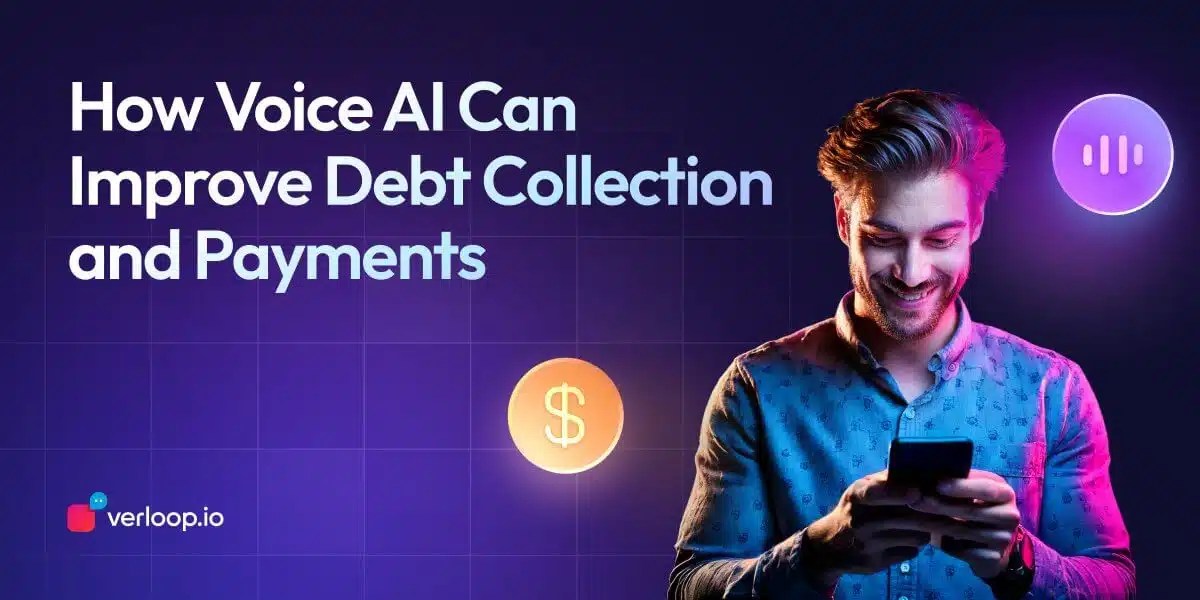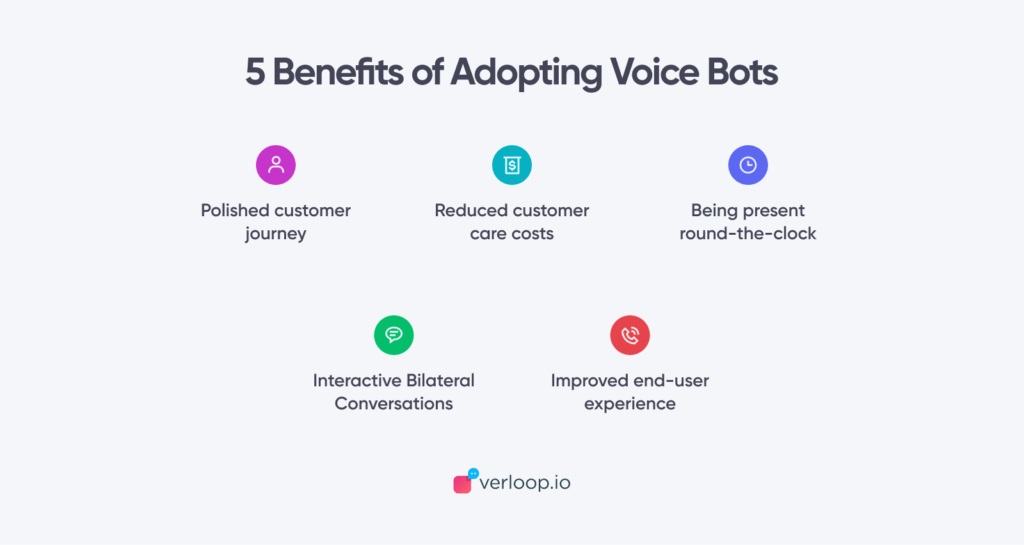
How Voice AI Call Agents Can Improve Debt Collection and Payments?
- March 12th, 2025 / 5 Mins read
-
Aarti Nair
If you are responsible for managing debt collections at your bank or fintech institute, you are in the right place.
You face daily challenges with overdue payments and customer enquiries, alongside making 100’s of calls a day for debt recovery. Finding an efficient way to handle them is key. Voice AI offers automated collections planning and execution, enabling operations to run 8 times faster. This means that your team can work more efficiently, with collector productivity growing between 2 and 4 times and response rates increasing by up to 10 times.
Consider a customer, let’s call her Sarah, who struggled to keep up with her repayments. When she received a call from a voice AI system, it clearly explained her options and helped set up a manageable repayment plan. This not only eased her concerns but also showed how AI-supported optimisation of debt recovery strategies can lead to a 25% or more cut in loan delinquencies.
In this blog, you will discover how integrating voice AI into your debt collection process can simplify communications and improve operational efficiency, making the whole process smoother for both your customers and your team.
Table of Contents
- What are voice payments?
- How do voice payments work?
- Challenges of voice payments
- Use cases a Voicebot can automate
- Benefits of voice payments
What are voice payments?
In early 2011, you might remember how IBM’s Watson stunned audiences on Jeopardy!
That same year, Apple introduced Siri, marking the beginning of voice technology becoming part of everyday life. These milestones opened the door to a new way of interacting with devices—one where you can speak and have your request understood and acted upon.
So, what are voice payments?
They let you complete transactions simply by talking to your device. With voice recognition now exceeding 90% accuracy and approaching 99%, these systems reliably guide customers through tasks like checking balances, transferring funds, or settling bills. Data from industry reports shows that as more people embrace voice assistants, the opportunity for smoother, more efficient transactions grows.
Imagine a scenario where a customer, after a conversation with a voice assistant about their overdue payment, receives a follow-up message on WhatsApp. In this message, you can include a secure payment link, giving the customer a clear and immediate way to complete the transaction. This approach combines the simplicity of voice interaction with the familiarity and convenience of WhatsApp, creating a seamless multi-channel experience.
For banks and fintech institutes, integrating voice payments with messaging solutions can streamline operations significantly. This blend of voice technology and messaging is an effective way to reduce friction in payment processes, making it easier for customers to manage their debts while enhancing your operational efficiency.
According to a Gartner analysis, AI bots expect to account for 40% of all customer care conversations. Voice bots quickly catch up to chatbots, now the most popular artificial intelligence (AI) communication tool. Voice bots are AI-driven computer programmes. When answering our questions or guiding us to someone else, voice bots function similarly to chatbots, but they do it by listening to our voice instructions.
Suggested Reading: Voice AI: The Ultimate Guide
How do voice payments work?
Setting up a voice payment account is quite similar to using any online wallet to make a payment. Customers must first connect the information from their bank account or credit/debit card to their gadgets. But in a typical wallet situation, the user would have to launch the app, physically type in the recipient’s information and the amount paid, and then push the “ok” button to complete the transaction.
Nevertheless, with voice payments, the user only needs to tell their gadget to make the payment using their voice. Then the following things will happen:
- The end-user is confronted by a screen asking for consent when the chosen payment app opens.
- The customer can authorise the transaction via a password or a quick biometric scan.
- The recipient will be sent a confirmation message of the sum received through email, text, or in-app alert on the other end of the transaction.
- The reverse procedure goes just as quickly. Tell your device to ask one of your friends to send you money, and the person on the other end will receive a message asking them to confirm the request.
Customers can view their financial accounts, keep track of their payment schedules, and make purchases.
Challenges of voice payments
Voice payments face many of the same difficulties every new technology faces: unfamiliarity and mistrust. Like any breakthrough technology, voice-enabled payments must demonstrate how they serve a need and get additional credibility because money is involved for them to be widely adopted.
The following are the main difficulties that voice payments now face:
1. Security and Privacy
Customers often worry about technology they cannot see or touch. Research shows that many people are uneasy about handing over sensitive information to a system that feels too personal. Ensuring robust security and clear privacy measures is key to winning over sceptical users.
2. Accents
Voice assistants still struggle with understanding a range of accents, particularly those outside of American English. Since much of the training data comes from American speakers, voices with different accents may be misinterpreted, leading to errors in processing transactions.
3. Point of Service (POS) Integration
For voice payments to work effectively, they must integrate smoothly with the hardware and software at retail points of service. However, the costs for integrating Wi-Fi or Bluetooth-enabled systems often fall on merchants, which can slow down widespread adoption.
4. Banking Institutions
Although some banks have started to adopt voice payments, rollouts remain limited. The need for significant global collaboration among financial institutions means that progress can be slower than anticipated.
5. Technology Limitations
Voice payment systems are still in their early stages. This means they sometimes lack the accuracy and reliability needed for error-free transactions, leading to potential misunderstandings.
6. Lack of Standardisation
Without a universal standard, different devices and platforms may not work well together. This incompatibility can create a fragmented user experience, making it harder for customers to rely on voice payments across various services.
7. Awareness and Adoption
Many people are not fully aware of how voice payments work or the benefits they offer. This unfamiliarity, combined with hesitation to change established habits, can slow the rate at which this technology is embraced.
Despite these challenges, voice payments have the potential to make transactions more straightforward and accessible. As advancements continue to improve accuracy, security, and standardisation, the obstacles will gradually diminish. In time, these improvements could lead to a smoother, more user-friendly payment experience that benefits both banks and their customers.
Use cases of voicebots in the payment industry

Voice bots assist in addressing the issues that contact centres face by lowering workloads and operational expenses while providing clients with quick, effective, and autonomous service.
1. Managing calls
Banks occasionally launch an outbound marketing campaign. Voice bots can assist banks by making hundreds or even thousands of cold calls to potential clients. What’s more exciting and resourceful about these calls is that voice interactions can enlighten customers with valuable insights into their individual needs and behaviours regarding payments, enabling companies to offer personalised services with a distinctive, unique brand experience.
Voicebots can converse with clients in a way that is natural-sounding and human-like. They can optimise certain information from a consumer regarding their data and schedule calls for various objectives. They can translate the human speech content into text with the help o
2. Qualifying leads
Voicebots help to generate and maintain a high conversion rate. Automated lead qualification with the help of voicebots enables more leads to be processed in a much shorter amount of time. Without the help of voicebots, a sales team member will have to manually enter and process the data, not being able to utilise that precious time to go into lead conversion.
Voicebots can easily filter the data and categorise between leads to accommodate agents to converse with the right customers and transfer calls to specific agents when a customer is interested to sign up for a service.
3. Customer verification
An agent must verify the customer’s identification before they can assist with a question about their bank account. This typically results in lengthy backlogs and can be challenging to scale up. Banks can manage the customer verification process using voice bots without interacting with people.
The payment voice bot can ask the caller for information about their data, quickly check it against the system, and verify their identification. The exact process performs for thousands of customers at once. They were putting a stop to misplaced or stolen credit and debit cards. This is the most helpful capability that banks can give voice bots when seen from the perspective of the client experience. Customers will immediately have to speak with an agent worried about the possibility of theft from their account or credit line.
4. Conducting customer satisfaction surveys
Satisfied customers add the best value to any business, and it becomes important to receive honest feedback on specific products and services. This is when a voicebot can take over and streamline the process, which elevates any customer retention strategy.
The voicebot can collect opinions of a variety of customers on a sensitive and significant topic like payments and incorporate ways into which this feedback can be executed wisely by the authority in charge, also while keeping different customer preferences in mind.
5. Assisting in the functioning of banking
The voice bot for payment is optional to transfer the call to an agent immediately after the client’s identity has been confirmed. It can perform various functions independently, including checking the account balance, sending money, and checking credit scores, among other things.
Benefits of voicebots in the payments industry

Voice bots have numerous advantages for company operations. The following are the main benefits of investing in speech automation:
1. Interact with consumers with cutting-edge voice bot technology
With advances in NLP science, intelligent voice control bots can now mimic the subtleties of speech. To understand it, it is necessary to hear about this evolution of natural language. This can be an excellent add-on for businesses to foster and nurture customer relationships.
2. Business procedures can be scaled up
Businesses train the bot to handle two or more chats simultaneously. On the other hand, voice bots have no such restrictions and can have multiple conversations with customers regarding payments of all kinds. This can help a business manage a high volume of tickets for payments.
3. Handing off
Voicebots can know when to refer a client to a person. Even though they are knowledgeable and sophisticated, voice bots won’t always be able to provide the correct solutions. For example, a voicebot can have trouble comprehending a payment request; in that case, the query can be shifted to a live agent. It can result in a good experience for the customer and a well-handled request for the company.
4. Superior customised partnerships
Voice-based interactions open new avenues for creating customised relationships. Voice bots, for instance, may instantaneously verify a consumer using voice recognition, and they can adapt their responses based on the user’s past interactions with a company. This can encourage a higher sense of security and trust within a customer for the company regarding as sensitive a topic as payments. It can also smoothen, fasten and simplify the entire transaction.
5. Reduced operational costs
Providing customer service 24×7 in the payments industry can be reduced drastically by using intelligent voice tools, considering that the cost of manpower, recruitment, training and onboarding can be heavy on the pocket for businesses. A voicebot can instead take over and automate and simplify the entire process while keeping the customers happy and meeting their needs.
6. Enhanced CX
Reduced wait times, quick responses and swift resolutions to payment queries and complaints can improve customer satisfaction and a customer’s overall experience. This can further result in a high rate of customer retention which is more profitable for businesses rather than newer customer acquisitions.
Bottom Line
With the ease and accessibility that voicebots offer customers, they are becoming an inseparable tool of E-commerce. They’re essentially altering and adding subtle nuances to how users search for products while making purchases. It gives customers an outstanding shopping experience and makes it simple for them to browse. This is thereby positively impacting the performance of a business and adding the element of trust between customers and businesses!
Verloop.io’s voice AI technology helps companies in the payments industry automate and streamline their methods with the help of voice bots. To save time and multiply efficiency, schedule a demo with one of Verloop’s conversational experts!
FAQs
- What exactly are voice AI in the payments industry?
Voicebots are AI-powered systems that allow customers to make payments, check account details, and resolve queries using only their voice. They provide an easy and hands-free way to interact with payment systems. - How do voice AI call agents improve the customer experience?
They offer a quick and intuitive way for customers to complete transactions. By reducing waiting times and simplifying processes, voicebots make managing payments smoother and more accessible. - Are voice call automation secure when handling payment information?
Yes, voicebots are built with strong security measures such as encryption and multi-factor authentication. However, it is important for banks and fintech companies to keep these systems updated to maintain high security standards. - Can voice AI call platform understand different accents and languages?
Voicebots are designed to recognise a range of accents and languages. Although some systems might still struggle with less common accents, ongoing improvements in AI and natural language processing are addressing these issues. - How can banks and fintech companies integrate voicebots into their existing payment systems?
Many technology providers offer APIs and integration tools that make it easier to incorporate voicebots into your systems. This integration can help streamline operations, improve customer engagement, and boost overall efficiency in handling payments.







